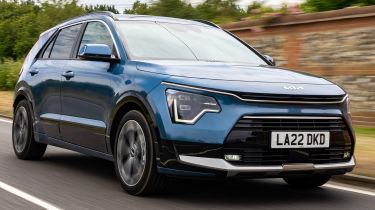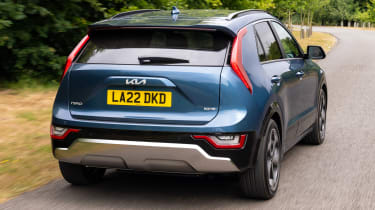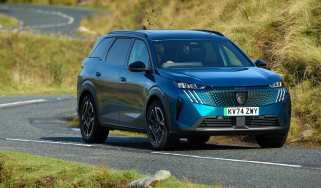Kia Niro PHEV review
The new plug-in hybrid Kia Niro improves on what was already a great family car with a longer range, class-leading tech and even better fuel economy than before

Pros
- 40-mile electric range
- Top-notch infotainment
- Spacious cabin
Cons
- Small boot
- Niro EV more refined
- Pricey top-spec model
| Car type | Electric range | Fuel economy | CO2 emissions |
|---|---|---|---|
| Plug-in hybrid | 40 miles | 280mpg | 23g/km |
The second-generation Kia Niro is one of a few cars available with a choice of hybrid (HEV), plug-in hybrid (PHEV) or all-electric (EV) powertrains. On paper, the PHEV seems to offer a strong all-round proposition: the convenience and ease of a HEV, with the low running costs and decent electric range of a full EV.
If you plug it in overnight, the Niro PHEV should deliver sufficient electric range to handle a typical daily commute. It could mean that you can effectively run it as an electric car during the week, leaving the petrol engine for longer trips at the weekend.
Under the bonnet is the same 1.6-litre petrol engine found in the previous model, but this latest iteration does get a new electric motor for a total of 180bhp, compared to 139bhp before. The size of the battery has been increased, too, meaning a longer electric-only range – up from 30 miles to 40. CO2 emissions have been reduced from 31g/km to just 18g/km on some models, and Kia claims fuel economy of up to 353mpg.
But, as always, it’s unreasonable to expect to see returns that high in reality, especially if you don’t top up the Niro’s battery whenever possible. The same goes for the 40-mile claimed range; we expect closer to 30 miles of silent electric running is more achievable day-to-day. Either way, that still makes it more efficient than rivals such as the MINI Countryman, Mercedes GLA and Renault Captur E-TECH plug-in hybrids.
The new Niro is longer, wider and taller than before as well, with much bolder styling. It borrows cues from the latest Sportage and Sorento SUVs, as well as the flagship EV6. At the front you get a set of angular LED daytime running lights paired with a thin chrome strip above the slim grille. The Niro’s rear is now more squared-off and features boomerang-style vertical headlights. Contrasting C-pillars are available, too, should you wish to make your Niro stand out a bit more.
The cabin has been overhauled, and is certainly a step up from the original Niro. The sweeping dashboard design, soft-touch surfaces and high-quality touch points help lift the cabin, although there are some cheaper plastics lower down – and the piano-black plastic on the centre console is susceptible to scratches and scuffs.
The infotainment system is class-leading; entry-level models get an eight-inch central touchscreen with Apple CarPlay and Android Auto connectivity as standard, while top-of-the-range Niros feature a pair of 10.25-inch screens running Kia’s latest infotainment system, including sat-nav. The user interface is intuitive and resolution is excellent. Our only major complaint with the setup is that responsiveness could be a little snappier.
There are three trim levels: 2, 3 and 4. The entry-level 2 features 16-inch alloy wheels, cloth upholstery, rear parking sensors, a rear-view camera, roof rails, smart cruise control and towing pack.
Moving up to the 3 adds 18-inch alloy wheels, wireless phone charging, cloth and vegan leather upholstery, heated front seats, a heated steering wheel, and front and rear parking sensors.
The flagship 4 feels decidedly upmarket, with a head-up display, a second 10.25-inch display for the driver, electric tailgate, sunroof, vegan leather upholstery, ventilated front seats and even a passenger relaxation seat.
When it comes to practicality, the Niro PHEV’s rear seats can easily accommodate tall adults with head and kneeroom to spare, although the 11.1kWh battery for the hybrid system does eat up a lot of boot space. In fact, the 348-litre boot is the smallest of the entire Niro line-up, with the fully electric Niro EV boasting a 475-litre load area.
Around town, the PHEV’s electric motor provides a smooth driving experience and enough power for effortless acceleration. At higher speeds, the e-motor also helps take load off the combustion engine, which can become harsh at high revs and under hard acceleration. Still, the transition between petrol and electric power is seamless and the six-speed transmission is relatively smooth with the electric motor helping to mask some of the delay when it kicks down. There is some wind noise and tyre roar at motorway speeds, but overall the cabin feels fairly isolated.
You can use the steering wheel-mounted paddles to manually select gears, but the Niro is better suited to a more relaxed driving style as the family SUV’s chassis and suspension are more focused on comfort than sportiness. We’ve had the benefit of trying all three versions of the new Niro, and this is probably the most comfortable of the bunch, able to soak up harsh bumps without any of the wallowing the heavier Niro EV experiences over larger road imperfections.The steering is accurate too, making the car easy to place on the road.
But all-in-all, the Niro EV is simply more refined and quicker, and doesn't have the same compromises to boot space as the plug-in hybrid. What’s more, the Niro PHEV starts at over £34,000, just a few grand shy of the Niro EV’s own starting price. As a result, the plug-in hybrid isn’t our pick of the Niro range.
On the plus side, even high-spec 4 trim creeps in below the premium VED (road tax) rate for new cars with a list price of more than £40,000. It means that the Niro PHEV will cost just £170 a year to tax from year two, a £10 saving over standard petrol and diesel cars, and, crucially, cheaper than the £560 rate for alternative fuel cars costing more than £40,000.
That said, if you’re not quite ready to commit to an electric car, the Niro PHEV can provide a glimpse at the EV driving experience, all in a comfortable, tech-filled and sharp-looking package. The significant reduction in practicality can’t be ignored, but if this doesn’t concern you then the Niro PHEV’s comfortable ride and strong zero-emissions range should earn it a place on your next family car shortlist.




